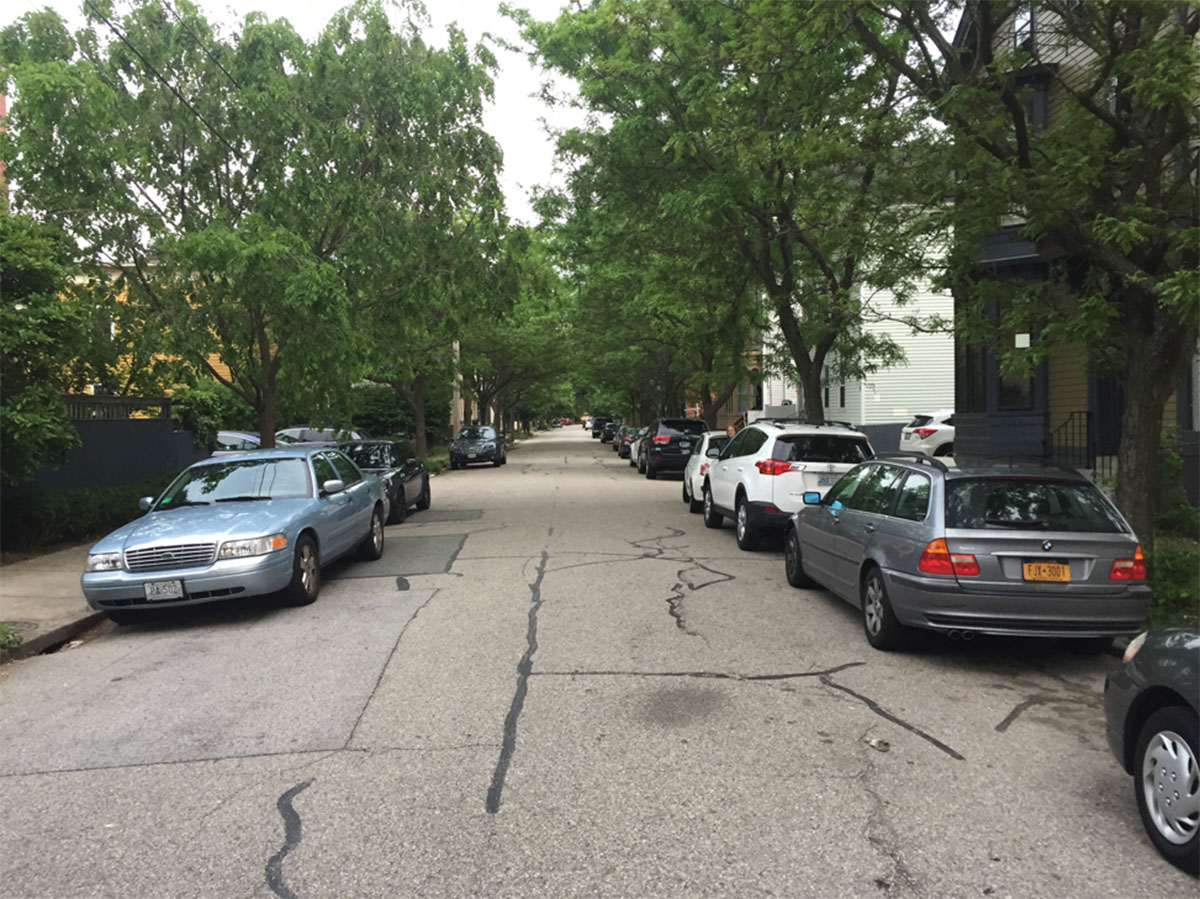
A few weeks back my wife and I were walking around the corner of our street on the west side when we noticed that if felt different. On both sides of the street the curbs were parked with cars—our neighbors across the street were having a house party. Typically there are few cars parked on our street, with the consequence that the street feels very wide and cars go speeding down it. But with the street densely parked the drive lanes are narrowed; drivers feel more constrained driving down the street causing them to slow down. Sometimes cars even have to stop to give way to a car going the other way, helping slow traffic on an otherwise quiet residential street with many children and pets. There’s even a name for this kind of street, a “give-way street.”
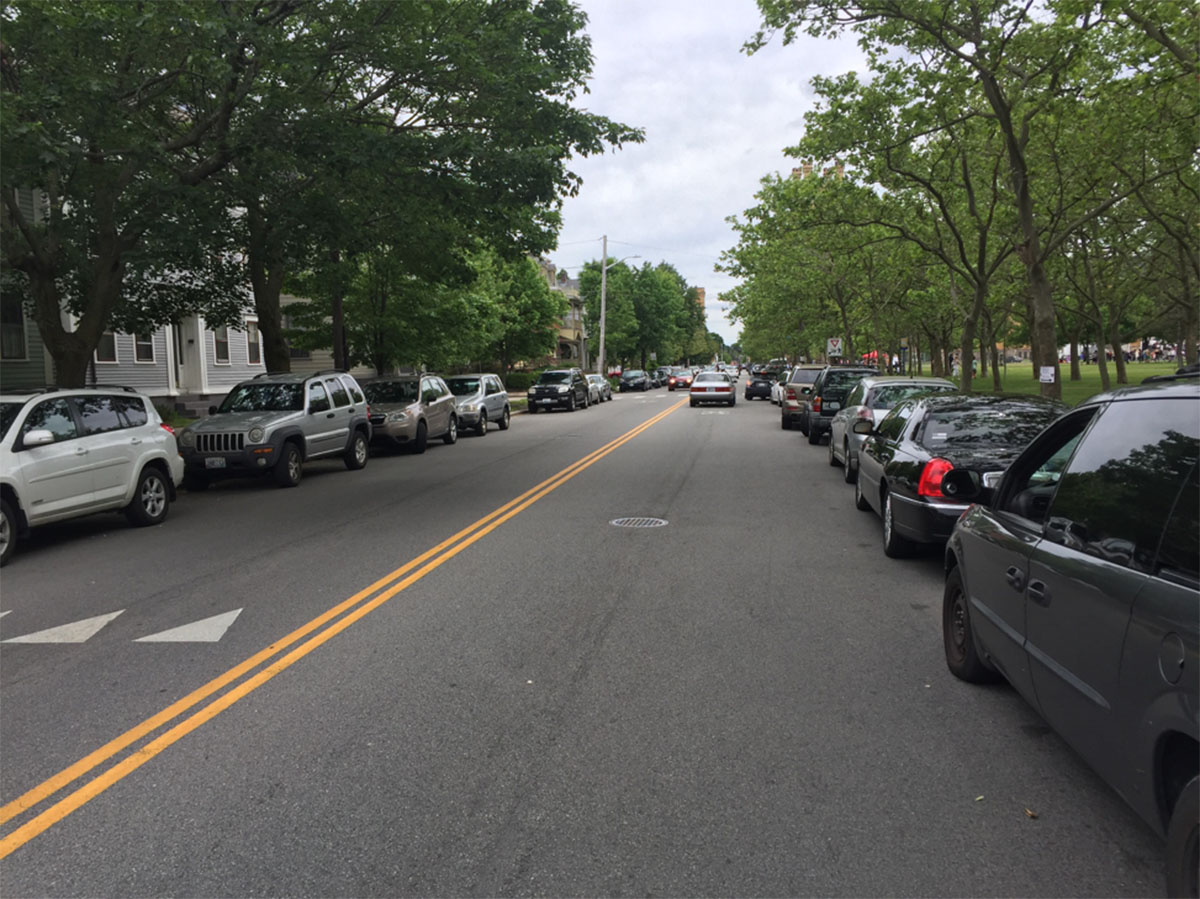
We saw another example of this phenomena during PVD Fest. The Sunday party in Dexter Training Ground meant that hundreds of cars were parking in the usually vacant on-street parking spaces around the park. Usually Dexter Street and Parade Street feature cars accelerating up the wide drives past a park where children play, but again the parked cars slowed traffic by narrowing the road width, and bonus: put a wall of steel between the moving cars and the sidewalk and park.
On street parking actually helps make our cities safer and more human scaled. But this is what many of our streets look like regularly.
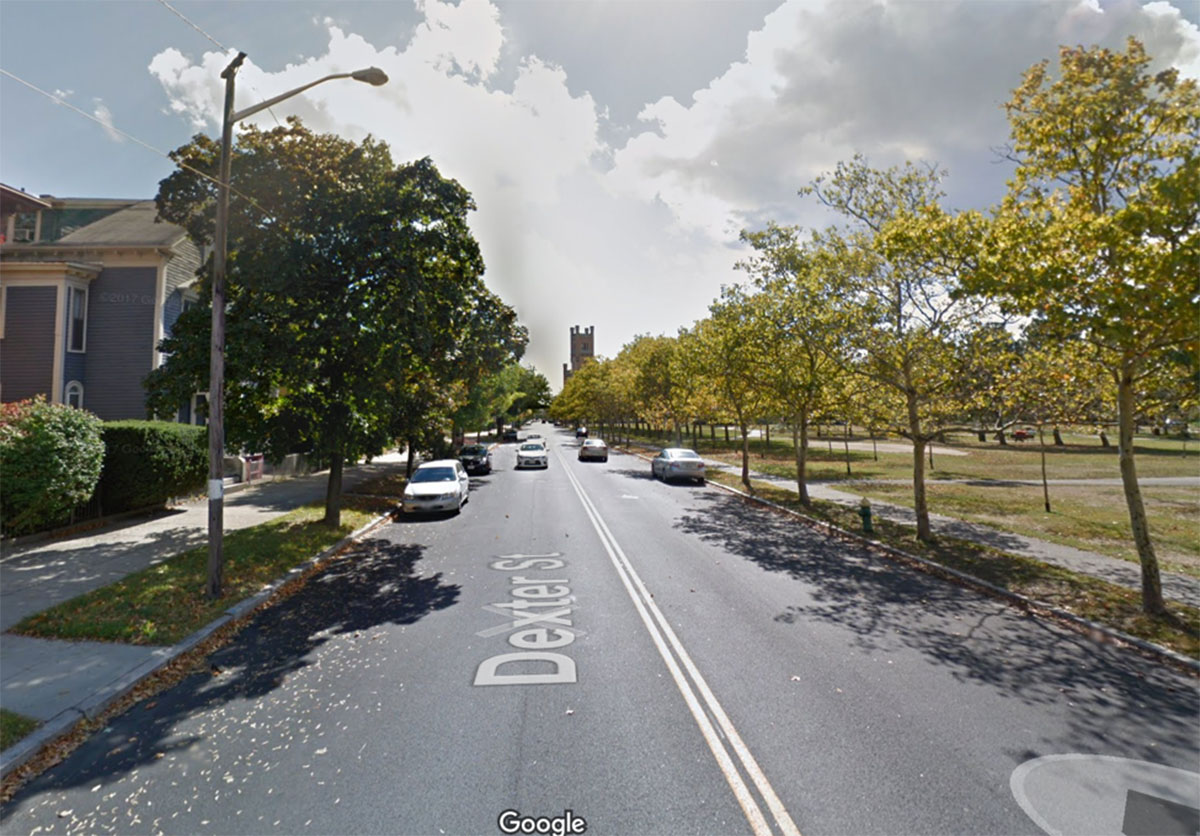
Image from Google Street View
Where are all the cars? Well, for decades suburban-style zoning regulations have required every building to provide parking for its occupants on site, which has mandated the paving of gardens and the demolition of structures to create parking lots. Similarly, for decades there was a prohibition against on-street parking overnight on city streets. This has recently been rolled back—now you can get a permit to park on street overnight. But you still have to get off the street in the event of a snow emergency, so there still has to be an off-street parking space for your car somewhere.
Off-street parking, in addition to widening streets and speeding up traffic, reduced open space, adds driveways and curb cuts, increases storm water flow and takes up scarce urban land which could house people or businesses instead of cars that aren’t being used 90% of the time.
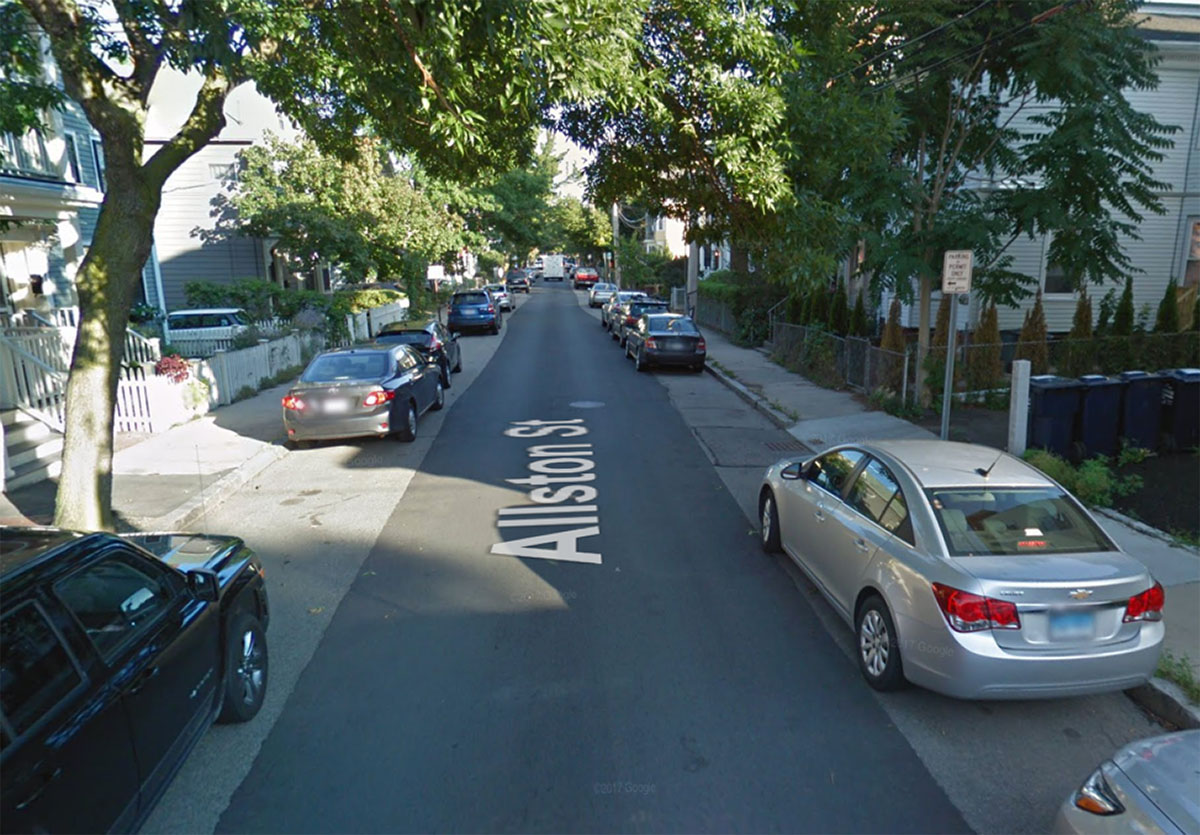
Image from Google Street View
Prior to moving to Providence, we lived in Cambridge, MA another dense urban neighborhood where most properties didn’t have parking (or enough of it) for all their residents, with the consequence that most everybody parks on street. The effect was to slow down traffic, protect the sidewalk, and connect people as they walked between their house and car. Rarely did I have to park more than a block away from my door (but even then—good exercise). It could be inconvenient to load and unload your car… but with the benefit that it discourages you from driving so much. And yes, we parked on street in the snow, and shoveled out parking spaces. In Cambridge the parking ban only applied to major commercial streets. It’s not perfect, but it worked.
We already pay for this pavement on the side of our roads through our taxes, why are we paying again for off street parking? Let’s get the full value from our roads and land. Providence could join its more prosperous urban cousins and actively encourage on-street parking. Allow on-street parking on side streets through snow storms, eliminate off-street parking requirements, and encourage filling in parking lots with people and businesses, so we don’t have to drive so much in the first place!

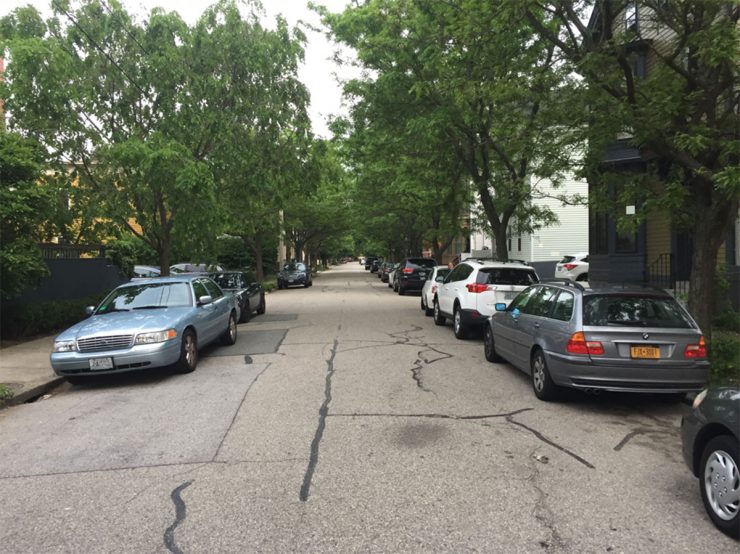


Well there’s barely any over night parking available and I’ll add I deal with speeding drivers on Sutton St constantly …. one evening I was out with my dog on the stoop and I could hear a car sharply accelerating from Atwells … nearly touching 60-70 in Porsche SUV I stepped into the road to try alert the operator thAt they should slow down… they swerved as if to hit me & then blew the stop sign at federal st
Welcome to the hood bro… nothing much changes around this town
Wished there was a garbage can to push into the street that would’ve slowed him up a titch.
If Dexter and Parade count as give-way streets, I’ve got a cycle-track on North Main and a right-of-way light rail system in Kennedy Plaza to show you.
I guess all things being equal I agree with this piece. Parallel parked cars are a type of traffic calming. But to set the bar low! What Dexter Park needs is a cycletrack, and lane reductions to the point that it actually _does_ operate like a give-way street. If it feels calm, it’s the Stockholm Syndrome of escaping Westmnster kto cking in.
I call proposals to just have mixed-traffic streets “auto-urbanism”, and it’s the lowest form of the genre. This is the kind nd of urbanism we get when we stop trying.
Also goes to show there’s more than enough space on most streets for protected bicycle infrastructure!! If you go to Copenhagen, there’s usually no street parking for their major streets, though there ARE curb-protected, wide bike lanes in both directions.
My goodness. Maybe after a few tough winters and various storm emergencies; this Yale vagabond will learn something. I have lived in Providence all of my life and have seen the ebb and flow of parking. It’s getting better, but there’s always a few who take it too far. These C-grade Yalies unfortunately inundate RI. A patch of Yale School of Architecture dead weight ers have latched onto the PawSox stadium debacle. At least Pawtucket has an escape release. Just ask the YSoAers about Suzanne Jovin, and they scram
Who said what to who now?
I wanted to come back and share my perspective on why I don’t think the streets featured in this are not particularly narrow.
I think it’s important for Providence folks to have perspective on what a narrow street really looks like, and setting a low bar is dangerous since it deludes people.
http://www.transportprovidence.org/2015/01/the-narrowest-street-in-providence.html
One of the things to note is that an average-sized neighborhood street in someplace like S. Philly is truly only wide enough to park a car against the sidewalk, and scrape one’s car slowly by the other car, without losing the paint. And yet that kind of street is actually really uncomfortable to ride a bike down, because a significant (if small) number of drivers will still act as though they own that type of street, and will rev behind you until you jump between the parked cars and give way.
There are probably a lot fewer injuries and fatalities due to this type of street, but it also spooks people, and we need to get to a place where people aren’t spooked by biking.
What also worries me a bit is, What happens when people get used to the new parking? Right now we have gotten people accustomed to not being able to park their car somewhere, but if we give people that space, they will start to think it belongs to them (#NoSavesies). So there’s a question of what the next step will be in the evolution of the street. If we could take baby steps like this and be assured they wouldn’t make it hard to take the next step, it would be less of an issue. But it is a really issue, because of how people treat parking spots.
Also, talk to our friends at ParkWithSpotter. They love this piece:
http://www.transportprovidence.org/2016/08/what-percentage-of-parking-spots-would.html
Mapes. I thought you were kidding about Paw. Turns out its a thing. On the Yale Architecture School website under courses. Smith is the studio director. ZOMG. I’m sure it won’t turn into a massive disaster ;-). Why does RI have to entertain Yalies? The thought of the Plattus creep in my hometown; Chills.
Exactly! Why does RI have to entertain every second-rate Yalie and every terrible Yalie project? The leader of that Yale School of Architecture baseball studio, Janet Marie Smith, is promoting the Hartford baseball stadium disaster as a model for Pawtucket. Obviously someone didn’t do their homework.